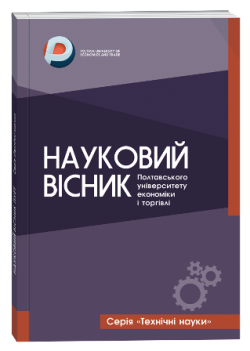DEVELOPMENT OF THE TECHNOLOGY OF FERMENTED DAIRY BEVERAGE WITH GLUTEN-FREE CEREALS
Abstract
Based on the literature data, spelt flour was chosen as a recipe component in the production of a fermented milk drink. Spelt protein is characterized by its high digestibility and excellent biological value. This grain also contains a high amount of unsaturated fatty acids and many phytosterols. Incorporating spelt into one's diet helps alleviate stress, fatigue, and nervousness, normalizes blood pressure, promotes immune system strengthening, regulates blood sugar levels, assists in optimizing the functioning of the brain and gastrointestinal organs, and prevents the development of cardiovascular diseases and oncology. The aim of the research is to determine the potential use of spelt in the production of dairy products and to provide a scientific rationale for the formulation of a gluten-free fermented dairy beverage while investigating its quality parameters. The research methods described in the article are generally accepted and were in force at the time of their implementation. The results of experimental studies confirm the effectiveness of incorporating spelt into the technology of fermented dairy beverages. It was found that the best option for beverage production involves adding spelt flour at a rate of 3% of the mass of the normalized mixture during cooling and mixing before bottling. The addition of spelt resulted in an increase in the viscosity of the fermented dairy beverage. This can be attributed to the hygroscopic properties of spelt grains, which lead to an enhanced moisture-holding capacity of the product. Consequently, the conducted research has deepened our theoretical understanding of the use of cereal crops in the production of fermented dairy beverages. The finished beverage with spelt is characterized by its therapeutic and preventive properties due to the presence of plant bioactive substances in its composition and is suitable for consumption by individuals with gluten intolerance.
References
2. Горач О. Аналіз споживчих властивостей мікрозелені та переваги застосування у харчуванні. Таврійський науковий вісник. Серія: Технічні науки. 2021. 5. С. 10–15. DOI: https://doi.org/10.32851/tnv-tech.2021.5.2
3. Господаренко Г. М., Любич В. В., Полянецька І. О. Якість крупи із зерна пшениці спельти та її зв’язок з умістом білка. Вісник ДДАЕУ. 2015. № 2. С. 11–15.
4. Лисюк Г. М., Постнова О. М., Богуславський Р. Л. Перспектива використання продуктів переробки полби у харчових продуктах. Прогресивні техніка та технології харчових виробництв ресторанного господарства і торгівлі : Збірник наукових праць ХДУХТ. 2005. Вип. 1. С. 224–230.
5. Любич В. В., Новіков В. В. Вплив параметрів водотеплового оброблення зерна спельти на показники ефективності вироблення борошна. Вісник ЖНАЕУ. 2017. № 2 (61). Т. 1. С. 134–138.
6. Наговська В., Гачак Ю., Михайлицька О., Сливка Н. Застосування пшеничних висівок як функціонального інгредієнта в технології кефіру. Науковий вісник ЛНУ ветеринарної медицини та біотехнологій. Серія : Харчові технології. 2017. 19 (80). С. 52–56. DOI: https://doi.org/10.15421/nvlvet8011
7. Наговська В., Михайлицька О., Сливка Н., Білик О. Розроблення технології кисломолочного напою зі спельтою. Географічна освіта і наука: виклики і поступ : матеріали Міжнародної науково-практичної конференції, присвяченої 140-річчю географії у Львівському університеті, м. Львів, 18‒20 травня 2023 р. Львів : Простір-М, 2023. С. 236–241.
8. Подпрятов Г. І., Ящук Н. О. Придатність зерна пшениці спельти озимої для хлібопекарських та кормових цілей. Новітні агротехнології. 2013. № 1. С. 71–78.
9. Твердохліб О. В., Голік О. В., Нінієва А. К., Богуславський Р. Л. Спельта і полба в органічному землеробстві. Посібник українського хлібороба. 2013. С. 150–172.
10. Angioloni A. I., Collar C. J. Nutritional and functional added value of oat, kamut, spelt, rye and buckwheat versus common wheat in breadmaking. Sci. Food Agric. 2011. V. 91. P. 1283–1292.
11. Bojnanska T., Francakova H. The use of spelt wheat (Triticum spelta L.) for baking applications. Plant, Soil and Environment. 2002. Vol. 48. Issue 4. P. 141–147. DOI: http://doi.org/10.17221/4212-pse
12. Dubois B., Bertin P., Mingeot D. Molecular diversity of alphagliadin expressed genes in genetically contrasted spelt (Triticum aestivum ssp. spelta) accessions and comparison with bread wheat (T. aestivum ssp. aestivum) and related diploid Triticum and Aegilops species. Mol Breed. 2016. № 36. Р. 152–157.
13. Kohajdová Z., Karovicová J. Nutritional value and baking applications of spelt wheat. Acta Scientiarum Polonorum Technologia Alimentaria. 2008. Vol. 5. Issue 3. P. 5–14.
14. Konvalina P., Moudry J., Capouchova I. Agronomic characteristics and baking quality of Triticum spelta L. Lucrări Ştiinţifice. 2013. Vol. 56. Issue 1. P. 11–14.
15. Kovaliova O., Tchoursinov Yu., Kalyna V., Koshulko V., Kunitsia E. Chernukha A. et. al. Identification of patterns in the production of a biologically-active component for food products. Eastern-European Journal of Enterprise Technologies. 2020. 2 (11 (104)). P. 61–68. DOI: https://doi.org/10.15587/1729-4061.2020.200026
16. Lacko-Bartosova M., Korczyk-Szabo J., Razny R. Triticum spelta – a specialty grain for ecological farming systems. Research Journal of Agricultural Science. 2010. Vol. 42. Issue 1. P. 143–147.
17. Mencia G., El-Qutob D., Pineda F., Castillo M. Occupational allergy to Triticum spelta flour. Allergol. Int. 2017. URL: https://www.ncbi.nlm.nih.gov/pubmed/28764943.
18. Nagovska V., Mykhaylytska O., Slyvka N., Bilyk O., Hachak Y. Influence of the biologically active supplement "Immunocort" on the production and quality of the "Mozzarella Ukrainian" cheese. Eastern-European Journal of Enterprise Technologies. 2023. 1 (11 (121)). P. 31–40. DOI: https://doi.org/10.15587/1729-4061.2023.272399
19. Ruibal-Mendieta N. L., Delacroix D. L., Mignolet Е. et al. Spelt (Triticum aestivum ssp. spelta) as a source of breadmaking flours and bran naturally enriched in oleic acid and minerals but not phytic acid. J. Agric. Food Chem. 2005. № 6. Р. 2751–2759.
20. Skrabanja V., Kovac В., Golob Т. et al. Effect of spelt wheat flour and kernel on bread composition and nutritional characteristics. J. Agric. Food Chem. 2001. № 49. P. 497–500.
21. Stankevych G., Kats A., & Vasyliev S. Investigation of hygroscopic properties of the spelt grain. Technology Audit and Production Reserves. 2018. 5 (3 (43)). P. 37–41. DOI: https://doi.org/10.15587/2312-8372.2018.146600


